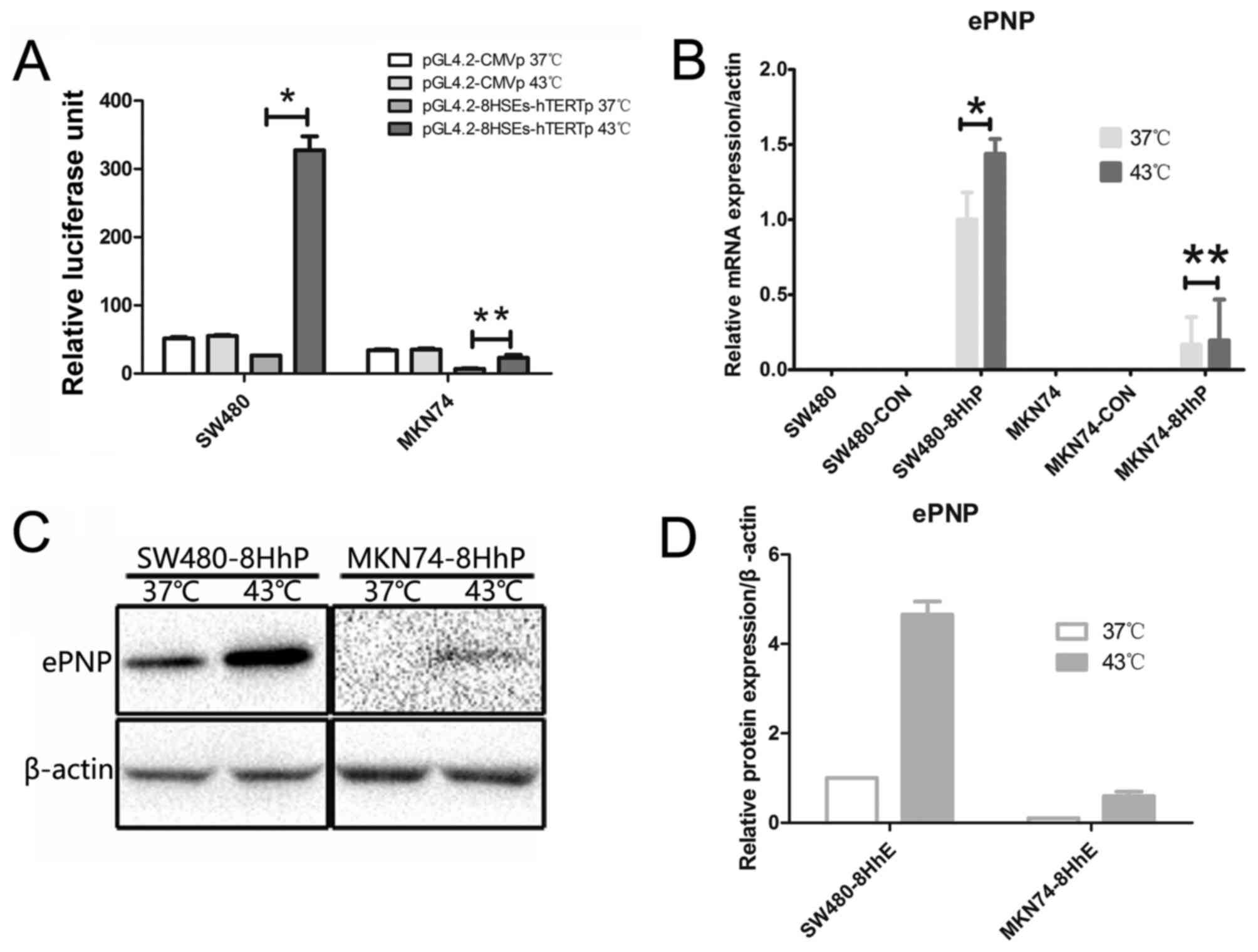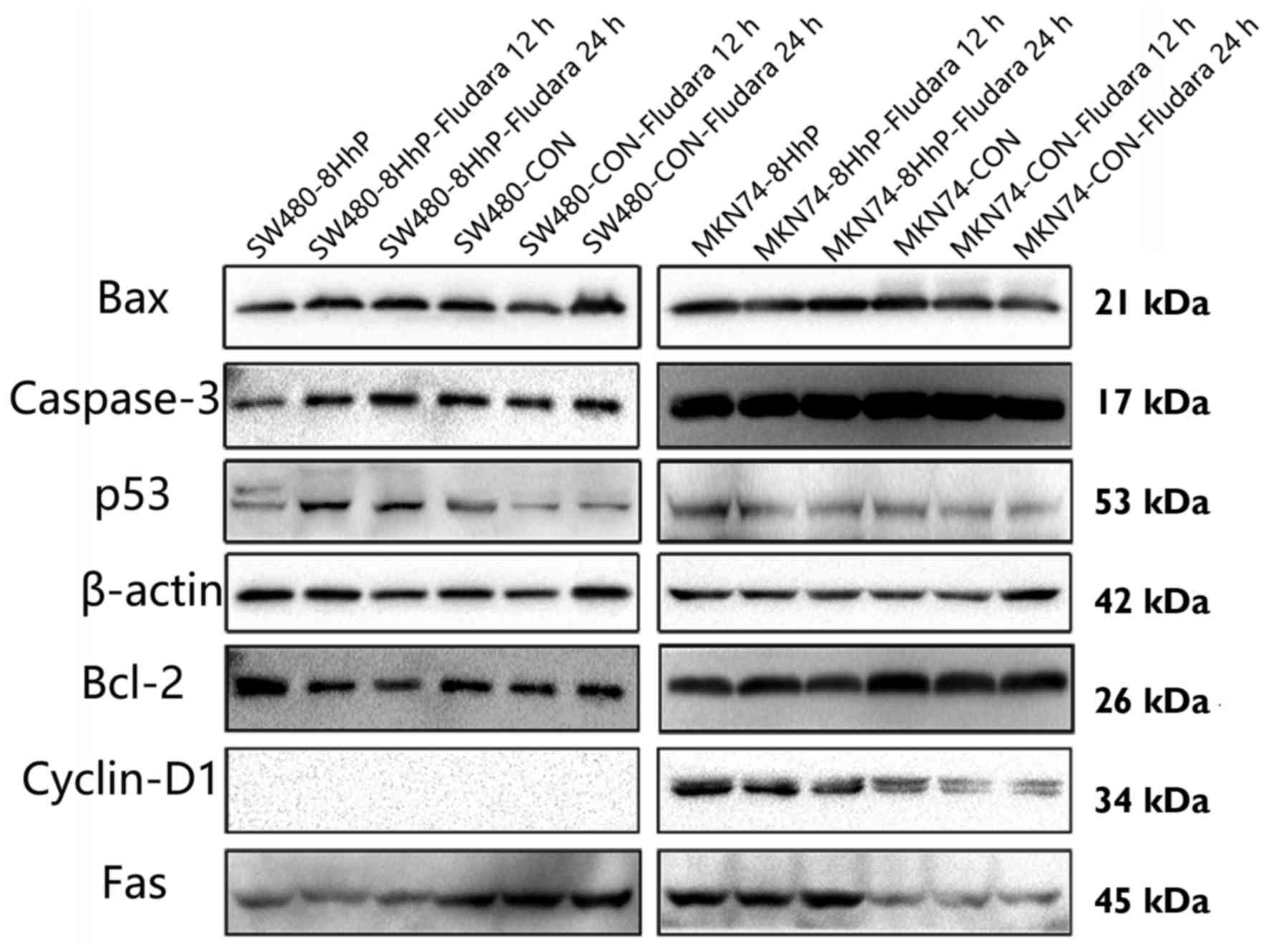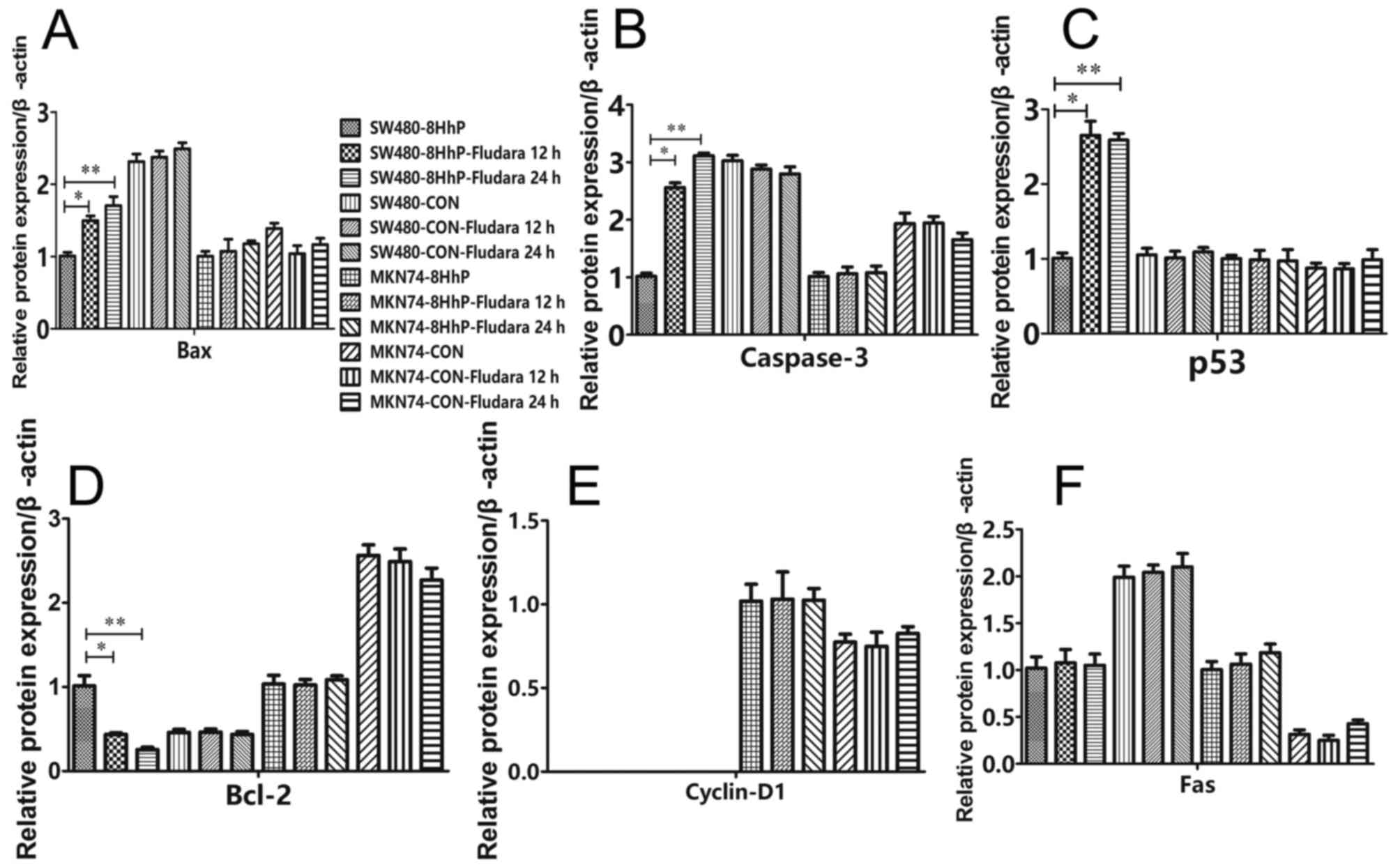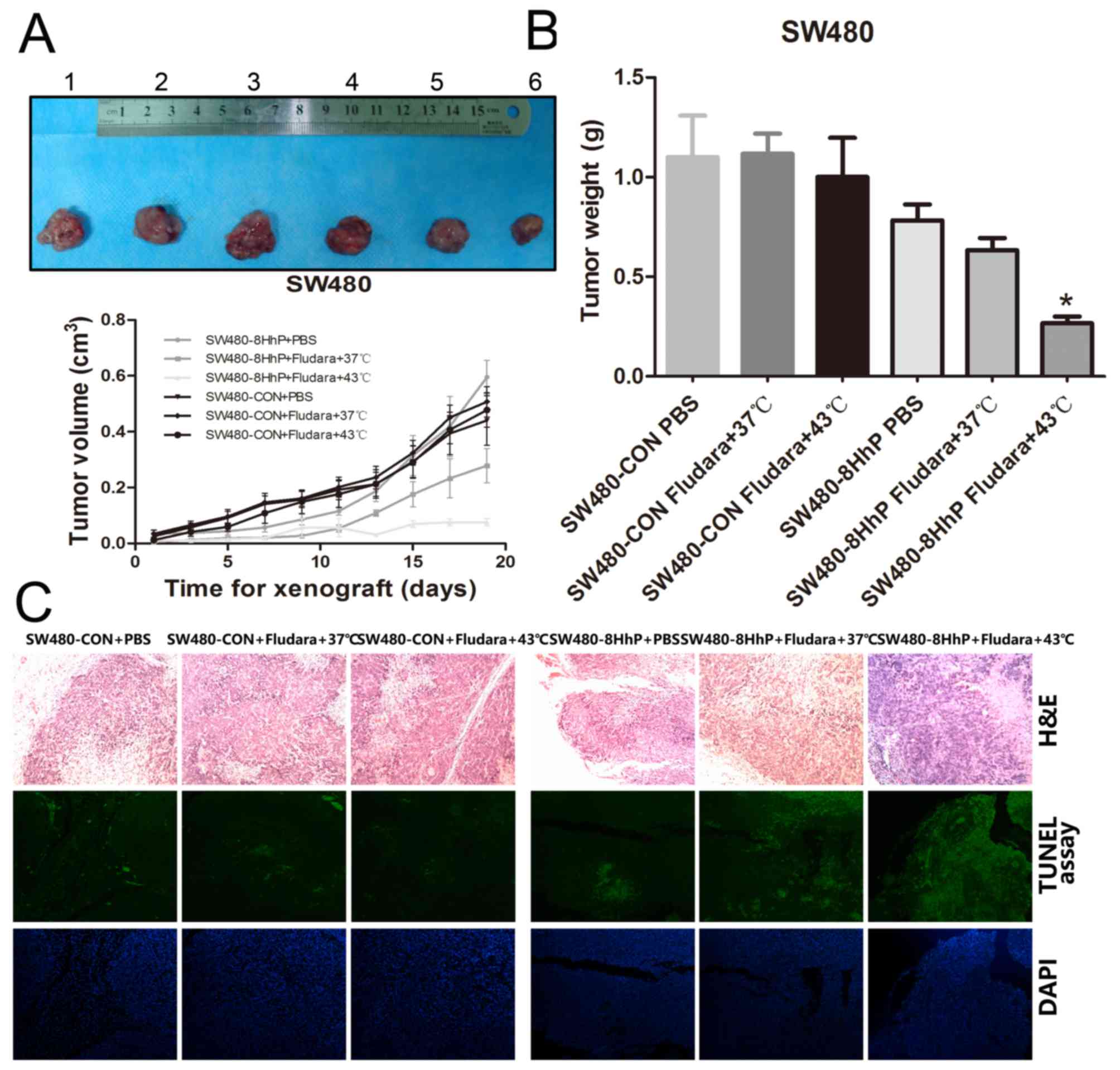|
1
|
Sorscher EJ, Peng S, Bebok Z, Allan PW,
Bennett LL Jr and Parker WB: Tumor cell bystander killing in
colonic carcinoma utilizing the Escherichia coli DeoD gene to
generate toxic purines. Gene Ther. 1:233–238. 1994.PubMed/NCBI
|
|
2
|
Afshar S, Olafsen T, Wu AM and Morrison
SL: Characterization of an engineered human purine nucleoside
phosphorylase fused to an anti-her2/neu single chain Fv for use in
ADEPT. J Exp Clin Cancer Res. 28:1472009. View Article : Google Scholar : PubMed/NCBI
|
|
3
|
Parker WB, Allan PW, Shaddix SC, Rose LM,
Speegle HF, Gillespie GY and Bennett LL Jr: Metabolism and
metabolic actions of 6-methylpurine and 2-fluoroadenine in human
cells. Biochem Pharmacol. 55:1673–1681. 1998. View Article : Google Scholar : PubMed/NCBI
|
|
4
|
van der Zee J and González DG: Regional
hyperthermia for rectal cancer. Lancet. 356:7722000. View Article : Google Scholar
|
|
5
|
Sherar M, Liu FF, Pintilie M, Levin W,
Hunt J, Hill R, Hand J, Vernon C, van Rhoon G, van der Zee J, et
al: Relationship between thermal dose and outcome in
thermoradiotherapy treatments for superficial recurrences of breast
cancer: Data from a phase III trial. Int J Radiat Oncol Biol Phys.
39:371–380. 1997. View Article : Google Scholar : PubMed/NCBI
|
|
6
|
Wust P, Hildebrandt B, Sreenivasa G, Rau
B, Gellermann J, Riess H, Felix R and Schlag PM: Hyperthermia in
combined treatment of cancer. Lancet Oncol. 3:487–497. 2002.
View Article : Google Scholar : PubMed/NCBI
|
|
7
|
Morimoto RI, Sarge KD and Abravaya K:
Transcriptional regulation of heat shock genes. A paradigm for
inducible genomic responses. J Biol Chem. 267:21987–21990.
1992.PubMed/NCBI
|
|
8
|
Brade AM, Ngo D, Szmitko P, Li PX, Liu FF
and Klamut HJ: Heat-directed gene targeting of adenoviral vectors
to tumor cells. Cancer Gene Ther. 7:1566–1574. 2000. View Article : Google Scholar
|
|
9
|
Hildebrandt B, Wust P, Rau B, Schlag P and
Riess H: Regional hyperthermia for rectal cancer. Lancet.
356:771–772. 2000. View Article : Google Scholar : PubMed/NCBI
|
|
10
|
Wang X, Zhou P, Sun X, Wei G, Zhang L,
Wang H, Yao J, Jia P and Zheng J: Modification of the hTERT
promoter by heat shock elements enhances the efficiency and
specificity of cancer targeted gene therapy. Int J Hyperthermia.
32:244–253. 2016. View Article : Google Scholar : PubMed/NCBI
|
|
11
|
Horikawa I, Chiang YJ, Patterson T,
Feigenbaum L, Leem SH, Michishita E, Larionov V, Hodes RJ and
Barrett JC: Differential cis-regulation of human versus mouse TERT
gene expression in vivo: Identification of a human-specific
repressive element. Proc Natl Acad Sci USA. 102:18437–18442. 2005.
View Article : Google Scholar : PubMed/NCBI
|
|
12
|
Cunniff NF and Morgan WD: Analysis of heat
shock element recognition by saturation mutagenesis of the human
HSP70.1 gene promoter. J Biol Chem. 268:8317–8324. 1993.PubMed/NCBI
|
|
13
|
Mosmann T: Rapid colorimetric assay for
cellular growth and survival: Application to proliferation and
cytotoxicity assays. J Immunol Methods. 65:55–63. 1983. View Article : Google Scholar : PubMed/NCBI
|
|
14
|
Parker WB, Allan PW, Hassan AEA, Secrist
JA III, Sorscher EJ and Waud WR: Antitumor activity of
2-fluoro-2′-deoxyadenosine against tumors that express Escherichia
coli purine nucleoside phosphorylase. Cancer Gene Ther. 10:23–29.
2003. View Article : Google Scholar
|
|
15
|
Pan Z, Sun X, Shan H, Wang N, Wang J, Ren
J, Feng S, Xie L, Lu C and Yuan Y: MicroRNA-101 inhibited
postinfarct cardiac fibrosis and improved left ventricular
compliance via the FBJ osteosarcoma oncogene/transforming growth
factor-β1 pathway. Circulation. 126:840–850. 2012. View Article : Google Scholar : PubMed/NCBI
|
|
16
|
Mocna M, Granja C, Leroy C and Stekl I:
Hyperthermia in oncology. AIP Conf Proc. 958:256–257. 2007.
View Article : Google Scholar
|
|
17
|
Akerfelt M, Morimoto RI and Sistonen L:
Heat shock factors: Integrators of cell stress, development and
lifespan. Nat Rev Mol Cell Biol. 11:545–555. 2010. View Article : Google Scholar : PubMed/NCBI
|
|
18
|
Zhang Y, Parker WB, Sorscher EJ and Ealick
SE: PNP anticancer gene therapy. Curr Top Med Chem. 5:1259–1274.
2005. View Article : Google Scholar : PubMed/NCBI
|
|
19
|
van Dillen IJ, Mulder NH, Vaalburg W, de
Vries EF and Hospers GA: Influence of the bystander effect on
HSV-tk/GCV gene therapy. A review Curr Gene Ther. 2:307–322. 2002.
View Article : Google Scholar
|
|
20
|
Chaudhary K, Ting LM, Kim K and Roos DS:
Toxoplasma gondii purine nucleoside phosphorylase biochemical
characterization, inhibitor profiles, and comparison with the
Plasmodium falciparum ortholog. J Biol Chem. 281:25652–25658. 2006.
View Article : Google Scholar : PubMed/NCBI
|
|
21
|
Hong JS, Waud WR, Levasseur DN, Townes TM,
Wen H, McPherson SA, Moore BA, Bebok Z, Allan PW, Secrist JA III,
et al: Excellent in vivo bystander activity of fludarabine
phosphate against human glioma xenografts that express the
Escherichia coli purine nucleoside phosphorylase gene. Cancer Res.
64:6610–6615. 2004. View Article : Google Scholar : PubMed/NCBI
|
|
22
|
Krohne TU, Shankara S, Geissler M, Roberts
BL, Wands JR, Blum HE and Mohr L: Mechanisms of cell death induced
by suicide genes encoding purine nucleoside phosphorylase and
thymidine kinase in human hepatocellular carcinoma cells in vitro.
Hepatology. 34:511–518. 2001. View Article : Google Scholar : PubMed/NCBI
|
|
23
|
Singh PP, Joshi S, Russell PJ, Nair S and
Khatri A: Purine Nucleoside Phosphorylase mediated molecular
chemotherapy and conventional chemotherapy: A tangible union
against chemoresistant cancer. BMC Cancer. 11:3682011. View Article : Google Scholar : PubMed/NCBI
|
|
24
|
Wang XY, Martiniello-Wilks R, Shaw JM, Ho
T, Coulston N, Cooke-Yarborough C, Molloy PL, Cameron F, Moghaddam
M, Lockett TJ, et al: Preclinical evaluation of a prostate-targeted
gene- directed enzyme prodrug therapy delivered by ovine
atadenovirus. Gene Ther. 11:1559–1567. 2004. View Article : Google Scholar : PubMed/NCBI
|
|
25
|
Pan D, Jin L and Zhang X: The latest
advances of experimental research on targeted gene therapy for
prostate cancer. Chinese-German J Clin Oncol. 12:546–550. 2013.
View Article : Google Scholar
|
|
26
|
Barese CN, Felizardo TC, Sellers SE,
Keyvanfar K, Di Stasi A, Metzger ME, Krouse AE, Donahue RE, Spencer
DM and Dunbar CE: Regulated apoptosis of genetically modified
hematopoietic stem and progenitor cells via an inducible caspase-9
suicide gene in rhesus macaques. Stem Cells. 33:91–100. 2015.
View Article : Google Scholar
|
|
27
|
Carlotti F, Zaldumbide A, Martin P,
Boulukos KE, Hoeben RC and Pognonec P: Development of an inducible
suicide gene system based on human caspase 8. Cancer Gene Ther.
12:627–639. 2005. View Article : Google Scholar : PubMed/NCBI
|
|
28
|
Chen Y, Shi S, Wang H, Li N, Su J, Chou G
and Wang S: A Homogeneous polysaccharide from fructus Schisandra
chinensis (Turz.) baill induces mitochondrial apoptosis through the
Hsp90/AKT signalling pathway in HepG2 cells. Int J Mol Sci.
17:10152016. View Article : Google Scholar :
|
|
29
|
Cali U, Cavkaytar S, Sirvan L and Danisman
N: Placental apoptosis in preeclampsia, intrauterine growth
retardation, and HELLP syndrome: An immunohistochemical study with
caspase-3 and bcl-2. Clin Exp Obstet Gynecol. 40:45–48.
2013.PubMed/NCBI
|
|
30
|
Karjoo Z, Chen X and Hatefi A: Progress
and problems with the use of suicide genes for targeted cancer
therapy. Adv Drug Deliv Rev. 99A:113–128. 2016. View Article : Google Scholar
|
















